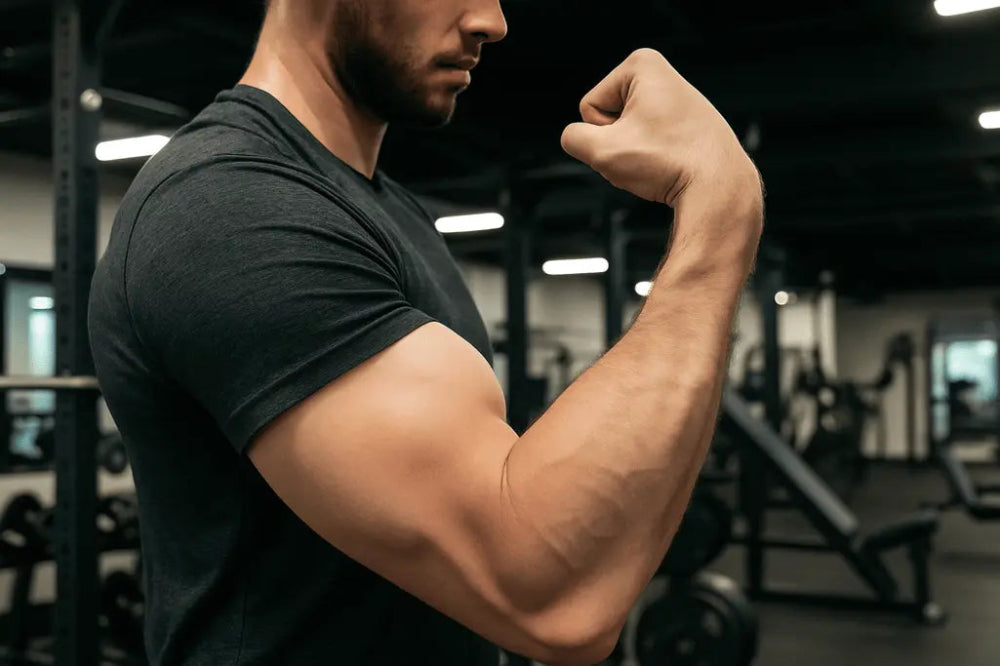You’ve set up on the bench, music blasting, plates loaded, spotter nodding.
The bar comes down smooth, but halfway up… your wrists buckle like cheap lawn chairs. Suddenly, your set feels less like chest day and more like a wrist torture test.
Sound familiar? Yeah, we’ve all been there.
Keeping your wrists straight when bench pressing isn’t just a “form tip”, it’s the difference between a strong press and weeks of nagging pain.
So, let’s understand why your wrists bend during bench press, how to fix it, and the one piece of gear that can instantly make you feel locked-in and powerful under the bar.
Why Do Wrists Bend When Bench Pressing?
 Here’s the thing: your wrists aren’t designed to carry heavy loads when bent back. They’re a hinge, not a shock absorber.
Here’s the thing: your wrists aren’t designed to carry heavy loads when bent back. They’re a hinge, not a shock absorber.
But if you let the barbell sit too high in your fingers, it forces your wrist into that ugly backwards bend.
Instead of your bones and joints stacking neatly, all the pressure slams into soft tissue. That’s why after a few heavy sets, you’re rubbing your wrists more than celebrating your new PR.
Picture this:
- Right way → bar sits low in the palm, stacked directly over your wrist and elbow, like a clean column of strength.
- Wrong way → bar wobbles in your fingers, wrist folds back, elbows flare… now you’re doing an accidental yoga pose instead of a bench press.
And here’s the kicker, a perfectly straight wrist isn’t the goal. A slight tilt back is normal.
What matters is stacking the weight over the joint so there’s no awkward leverage fighting you.
Fixing Wrist Position on the Bench Press
The first step to fixing this issue is awareness. Most people do not even realize their wrists are bending until the pain shows up.
Next time you are under the bar, focus on how the weight feels in your hands. Here are adjustments that make a big difference:
1. Place the bar lower in the palm
The bar should rest in the meaty base of your palm, close to the wrist joint, not up in your fingers. This allows the force to travel straight through your forearm rather than bending the wrist.
2. Use a full grip
Wrapping your thumbs around the bar may sound obvious, but many lifters still use a thumbless grip. While it might feel comfortable at lighter weights, it removes control and stability.
A full grip locks the bar in place and keeps your wrists safer.
3. Choose the right grip width
Grip too wide and your wrists collapse outward. Grip too narrow and your elbows flare awkwardly. A shoulder-width grip or slightly wider usually keeps everything in balance.
4. Strengthen wrists and forearms
If your wrists are weak, even perfect technique may not save you under heavy loads. Adding simple wrist curls, grip ball squeezes, and knuckle push-ups to your routine can build durability.
Stronger forearms give your wrists the backup they need during pressing movements.
Best Wrist Wrap for Bench Press Power
 Here’s the truth, even with perfect form, heavy weight exposes weak links. And for most lifters, the wrist is the first thing to cave. That’s why pros don’t bench raw; they use wraps.
Here’s the truth, even with perfect form, heavy weight exposes weak links. And for most lifters, the wrist is the first thing to cave. That’s why pros don’t bench raw; they use wraps.
Gripzilla Lifting Wrist Wraps aren’t just a “nice-to-have.” They’re like strapping a seatbelt on your wrists before a high-speed lift.
What they do for you:
- Lock alignment in place → The bar stays stacked directly over the joint.
- Kill the pain → The wraps absorb that extra pressure so your wrists don’t scream mid-rep.
- Boost confidence under the bar → When your wrists feel like steel rods, you focus on pushing weight, not fighting form.
- Versatile for all lifts → Bench, overhead press, curls—you name it, they keep you stable.
Bringing It All Together
So how do you keep your wrists straight when doing bench presses?
Start by setting the bar lower in your palm, gripping fully with thumbs around the bar, and choosing the right grip width. Build stronger wrists and forearms so your joints are not left vulnerable.
And when the weight gets heavy, give yourself the support you need with Gripzilla Lifting Wrist Wraps.



